12/12 - 15/1
Before moving to London in 1994 Tamiko and I lived in Kobe for several years, so we are on home territory, so to speak. The three weeks travelling along the north coast in increasingly bad weather were not so easy, and coming back into the Kansai area is a great relief. The weather is more temperate, and I have the feeling of being surrounded by all kinds of activity, but not rushed and frenetic as Tokyo was.
For the past few years whenever I have been staying with my in-laws I have been taken pictures of the area, as just outside the apartment is an uta stone from the Man'yoshu.
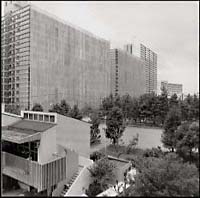
At the dock of Muko bay
Heaven is moving -
And as the day ends
I think of home
Anon. Man'yoshu vol. 17 #3895
As with many of the utamakura whose topic is the sea I am presented with the dilemma / choice of taking a photo at the location of the utamakura stone or of going to the present-day coastline that is nearest the original utamakura. In the case of Mukogawa, the coastline, as a result of a combination of natural geographical processes and the building of artificial islands, has moved about 2 kilometres south. I choose to take a photograph from the veranda of the apartment as a little nod to Andreas Gursky.
After a few days at Mukogawa we move to central Osaka from where we can reach several sites to the east and south. I have a strong affection for Osaka's rough and ready metropolitanism, but I have to admit that the homogeneity of its grimness is only broken by areas that are so forlorn that the buildings and covered streets seem to have organically congealed in the outpourings of grease from a hundred ramen shops. Before any Osaka readers start sending complaints about this description, let me just say that this is a compliment.
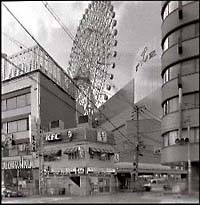
Waving coyly - a silk tree in Tsugano
Where rumours about my lover abound
I can barely stand
Waiting - always she is in my thoughts
Anon. Man'yoshu Vol. 11 #2752
As far as the classical poetry anthologies are concerned the main recurring subjects of uta in this area were the reeds of the bay and the beauty of the coastline of what was then called 'Naniwa in the land of Tsu', which was referred to almost as an earthly paradise. Many of the poets of the later collections would write of the beauty of Naniwa purely on the basis of reputation since in fact they had not been there themselves. In this respect I have a clean conscience about taking pictures anywhere in the modern Osaka area to represent these uta.

Once known as Naniwa
Here we have built a palace -
How like a capital
This country has become
Fujiwara Umakai. Man'yoshu vol. 3 #312
At Temmabashi, close to were we are staying:

As night deepens
The sound of the oars
Of the boats on the Horie, grows louder
I wonder, how swiftly does the river flow -
Anon. Man'yoshu vol.7 #1143
To the south of Osaka the suburbs and factories spread out along the coast towards Wakayama. Dotted amongst the smokestacks and the fifties blocks are more specific utamakura - at strangely named Kire Uriwari at sunset:
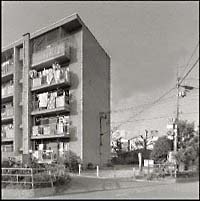
Cutting reeds,
The palace servants hear
The sound of oars
From the boats on the Horie river
Otomo no Yakamochi. Man'yoshu vol. 20 #4459
Although one of the main compilers of the Man'yoshu anthology, Otomo no Yakamochi seems to have had a dislike of the politics of court life, and did not rise very high in the hierarchy, despite an illustrious family background. As we have come across utamakura with his and his father's poetry several times in our travels we are beginning to feel some attachment to their work.
Further south the housing gets less dense, and we alight at Asaka station which straddles a bridge over the river Yamatogawa:

As evening falls, the tide
Rises into Asaka bay at Suminoe
I wish I were there
Harvesting the rich seaweed
Prince Yuge writing to Princess Ki. Man'yoshu Vol.2 #121
One day we go east to the hills of Ikoma. As we travel out of the city the smog gets thinner, and eventually we come out into a clear blue sky. We take a cable car to the top of Ikoma san where there is an amusement park and as it is the day after a national holiday there are only a handful of visitors.

Longing for my wife
I saddle the horse
Hurrying to her
Over Ikoma mountain
The autumn leaves are falling
Anon. Man'yoshu vol.10 #2201
It is after Christmas when we leave Osaka, and we go back to Tamiko's parent's from where we can visit sites around the Kobe area. However flu keeps me in bed until well after New Year.
When I am well enough to travel I go back to an area west of Kobe that I am very familiar with - and perhaps where I got my taste for industrial landscapes, as I used to teach in several of the steel factories along the coast. By some strange coincidence there is an utamakura at each of the factory sites where I used to work. Two of them are:

Deep in this great sea of Inami
Hidden by a thousand waves
The island of Yamato rises
Kakinomoto no Hitomaro. Man'yoshu vol.3 #303

I will leave tomorrow
The Inamu river
Flowing ever on
The one I love already gone
Anon. Man'yoshu vol.12 #3198
One day we go on a family outing to the Wakayama peninsula, where at Kimiidera temple we cross paths with Basho once again, though the haiku is not from the Oku no Hosomichi travel journey:
Looking up
The cherry blossom cleared away
Kimiidera
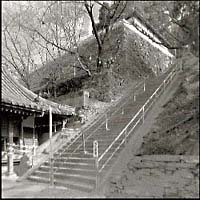
As it is early January there is no blossom, of course, but after I have pressed the shutter two workman set up a ladder and take down the fairy lights.
We go down the hill and stop at the bay - Waka no Ura - that has a special significance in poetry since 'Waka' is a homophone for the Japanese word for verse. It is surprisingly hot for January and the sea and hills in the distance are obscured by haze.
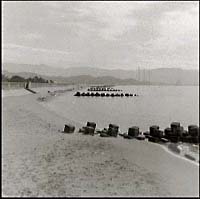
The tide rises in Waka bay
As the mud flats disappear
Cranes crying out
Flying towards the reeds
Yamabe Akahito. Man'yoshu vol.6 #919
On another day, nearer to home, between a petrol station and second-hand car dealer's:

My tears fall In Ashiya
Standing at the grave
Of the maiden Unahara
Takahashi no Mushimaro. Man'yoshu vol.9 #1810
A few kilometres from the apartment an uta by Otomo no Yakamochi's father Otomo no Tabito:
Sea-diving maidens
Do they make fires
In matsubara?
Man'yoshu vol.17 #3899
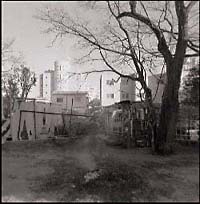
At dusk we go to a town where some of our friends live and before we visit them to eat and drink sake we go to the beach, the sunset lights up the clouds.

If I pity the lonely twilight sky
When the smoke of boiling brine
Rises into space
Is there any relief?
Fujiwara no Hideyoshi. Shinkokinshu #1603
|
|
1998年12月13日〜
1999年1月18日
一ヶ月以上、西宮を拠点に関西エリアの撮影。途中で年も改まっているものの、すべて日帰りの旅なので思い出すままにスケッチしてみるつもりだ。
★車で湾岸線を走り和歌山へ。途中のサービスエリアで地図を貰いまずは紀三井寺へ向かう。重い器材を自分で運ぶ必要もなく目的地まであっさり到着する車の旅は楽だ。関西空港を通り過ぎ、和歌山まであっという間の1時間。紀三井寺は除夜の鐘で有名なお寺らしい。お土産やのおばさんの誘導で有料駐車場に500円払い、200段以上有りそうな石段を上がっていく。頭上を小さな電球がすらりと釣り下げられているのは、大晦日の初詣で用なのだろう。夜の参拝者が多そうだ。石段から和歌の浦を見下ろす。
身あぐれば 桜しもうて 紀三井寺 (松尾芭蕉)
その名も和歌の浦へ。海岸線に沿って進む埋め立てが問題になっているところ。半島の形をした埋め立て地に「万葉館」や「万葉の小路」があるが見事に無人だし、垣根を越えた反対側の方男波海水浴場にも平日の冬の午後、子連れの若夫婦と新聞を顔にかぶって昼寝をするおじさんと自転車ではしからはしまでの往復を繰り返す目つきのするどいおじいさんの外に人影はなく、たださんさんと太陽が照っている。夏の海水浴客用のシャワーや着替え部屋や、その他の施設が所在なげにたたずんでいる。
和可の浦に 潮みちくれば かたをなみ あしへをさして 鶴なきわたる
(山部赤人 万葉集 6-919)
帰りに、道路脇に放置してある台から有田みかんを買う。100円で、大きなビニール袋にいくつも入っていたみかんは、家に帰って食べてみたらとても甘かったので、もっと沢山買って来るべきだったと大きな後悔。
★ 大阪市地下鉄とJR阪和線を乗り継ぎ堺市の浅香へ。駅を出るとすぐ脇を流れる大和川で撮影。この辺りは浅香潟、浅香の浦と呼ばれた入江だったらしい。撮影の間、見ている間にもどんどん人数が増えて行く釣り人を眺める。川の水はミルクコーヒー色で、地獄温泉のごとくふつふつと泡立っているところもある。こんな所に住む魚を食べるなんて勇気ある行動だと思っていると、あちこちでぼちゃん、どぼんと水音がするのでよく見れば釣った魚がその場で放されているのだった。30cmくらいある大き目のフナなどが、頻繁に釣り上げられたかと思うと、すぐに10mほども下の川面に向かって放り投げられていく。釣るより釣られる方が大変そうだ。もしかすると、同じ魚が何度も色いろな人に釣り上げられているのかもしれない。
夕さらば 潮満ち来なむ 住吉の 浅香の浦に 玉藻刈りてな
(弓削皇子 万葉集2-121)
川沿いに北へ歩いていく。住宅地を抜けると小さな商店街がありおいしそうなたこ焼のにおいがしている。並んでいるおばあちゃんが「ここはおいしいでえ。」と言うので買って食べる。たこ焼10個で180円。
大舟の 泊つる泊まりの たゆたひに 物思ひ痩せぬ 人の児ゆゑに
(弓削皇子 万葉集 2-122)
★地下鉄谷町線で喜連瓜破へ。「きれうりわり」と読む。音も字も美しいと思う。
葦刈りに 堀江漕ぐなる 梶の音は 大宮人の 皆聞くまでに
(万葉集 20-4459)
★ 天満橋から大川を撮影する。
さ夜ふけて 堀江漕ぐなる 松浦舟 梶の音高し 水脈速みかも
(万葉集7-1143)
★ 地下鉄御堂筋線でなんばへ。北東に歩いて三津寺へ。御堂筋からひょいと三津寺筋を東に折れると繁華街の真ん中にひそりとお寺があるのに驚く。車がひっきりなしに通るためここでの撮影は諦め辺りを歩きまわる。御堂筋をはさんで反対側の筋に入る。ここも細い路地を大型の車が絶えず走っているが、アメリカ村が近いため若者の歩行者が数で勝っていて車は軒並み徐行せざるをえない。隙間を縫って撮影。ゴミ箱からごそごそ音がするのでじっと見ていると巨大なノネズミが顔を出す。すぐ潜ってしまったが、エサが良いのかまるまる太って尻尾の長さは20cm以上あったような気がする。辺りを歩きまわる人間達よりずっと血色もよさそうだ。
大伴の 三津の浜なる 忘れ貝 家なる妹を 忘れて思へや
(身人部王 万葉集 1-68)
★ 大阪梅田で撮影。最近できて人気らしいビル屋上の観覧車を写す。
我妹子を 聞き都賀野辺の しなひ合歓木 我は忍び得ず 間なくし思へば
(万葉集 11-2752)
★ 地下鉄中央線から近鉄電車に乗り換えて生駒へ。コンビニでお弁当を買ってロープウェーに乗りピクニック気分で生駒山上遊園地へ行く。隣の席のそれぞれ2人づつ子供を連れた若お母さん2人組がやたらと大声で話している。ひとりは持病の辛さを切々と訴え、もうひとりは子供が通う保育園の先生の噂話をしている。お互いの話はまったく聞いていないようだが、時々微妙に話が噛み合ったりもしているようで、そこはかとなく禅的だ。山頂に到着すると我先に駆け出して行った。遊園地は逃げないと思うが。とりあえずゆっくりお弁当を食べるところでも探そうとうろうろするも、山上にはどうやら遊園地しかないらしい。ハイキング用の裏道とか下界を見下ろす広場とかベンチとかそういうものが何もないらしいので、少々がっかりしながらその辺の道端に座ってお弁当を食べることにする。食べ終わると、あとは遊園地に入るしかない。渋々入園料を払い入園する。何故山の上に遊園地を作らないといけないのかわからないが、一応一周してみる。見ているだけでめまいに襲われるような乗り物に囲まれて平均より弱い三半規管が疼きそうになったので、乗り物エリア脱出を試みる。冬期は閉鎖しているらしい食堂の裏手に回ると鳥居があり30段あまりの階段を降りていくと神社がある。あれあれと思っている間に中から柴犬のチビが走り出てきて膝に飛び付きざま顔を舐めようとする。また出会ったフレンドリーなペットだ。しばらく犬と遊んでいると、神社のひとびとが座卓や座布団やお酒や食べ物を手に裏手の物置小屋のような建物に入っていく。神主さんらしき人に会釈するとにっこり会釈を返してくれる。これから忘年会らしい。まもなく小屋から歌声が聞こえてくる。
妹がりと 馬に鞍置きて 生駒山 打ち越え来れば 黄葉散りつつ
(万葉集 10-2201)
★ 地下鉄御堂筋線で心斎橋まで行き、難波の方角へ歩く。途中、「ひっかけ橋」とその名を馳せる戎橋で撮影。
昔こそ 難波いなかと 言はれけめ 今都引き 都びにけり
(藤原宇合 万葉集 3-312)
★ 地下鉄谷町線で谷町4丁目へ。東南へ歩いて難波の宮跡へ行く。史跡公園として整備されたこの場所を夕方近くの時間占領するのは飼い主に連れられた犬達だ。お行儀の良いのは鎖から放たれ嬉しそうに辺りを飛び廻っている。大きいの、小さいの、高そうなの、馬鹿そうなの、とりどりの犬達があらゆる方向からやってきて走り回り跳ね回り大騒ぎしている。その間飼い主達も寄り集まって井戸端会議の様子。石段で高くなった宮跡から、じわじわとオレンジ色が濃くなるオフィス街の夕空を背景に繰り広げられるそんな景色を眺めながら撮影を済ませる。
大宮の 内まで聞こゆ、網引すと 網子ととのふる 海人の呼び声
(長忌寸奥麻呂 万葉集 3-238)
★ 阪神電車で西宮東口駅まで行く。松原町の撮影。住宅地の中にある松原神社へ行く。絵馬を覗き読みすると受験祈願ばかり。菅原道真縁の天満宮らしい。いったん神社を通り抜けて海側にある鳥居をくぐると枯れた池がある。たき火を撮影。
海人娘人 いざり焚く火の おぼほしく 角の松原 思ほゆるかも
(大伴旅人 万葉集 17-3899)
★ 七色の街レインボータウンこと西宮市武庫川団地で撮影。
たまはやす 武庫の渡りに 天伝ふ 日の暮れ行けば 家をしそ思ふ
(万葉集 17-3895)
★ 阪神電車石屋川駅から徒歩で処女塚へ行く。以前撮影に来たのだが、出来上がりが気に入らず再撮影。43号線に架かる歩道橋の上から人家越しに乙女塚にカメラを向けていると、通り掛かりのおじさんおばさんが不審気にじっと見ていく。一人のおばちゃんは好奇心旺盛らしく、「鳥でも撮ってんのお?」とファインダーを覗いていく。嬉しそうに覗いた後、あれえ?と頭上に吹き出しをつけて小首をかしげながら行ってしまう。
葦屋の 菟原処女の 奥つ城を 行き来と見れば 音のみし泣かゆ
(高橋虫麻呂 万葉集 9-1810)
★ 天候不順のため撮影見合わせかと思っていたところ、「ホームセンター」へ買い物へ行く家族の車に便乗できることとなり慌てて用意して今津ハーバーまで連れていってもらう。駅から遠いのでちょうど良かった。天気に追いかけられるように浜辺を撮影。公園として整備が進められているようで工事中だったが、「すみませえん」と言いつつ入れてもらう。木製の灯台が割合有名らしく、今朝もカメラマンが来ていたよ、と工事のおじさんは言うが、Johnが真反対の方向にカメラを向けているので、「こっちじゃないの?そっちなのお?」と驚いている。ごもっともだ。さっさと仕事を終えて「ハムスターの回し車」を買いにホームセンターへ。家で飼っているハムスターのチャッピーちゃんが毎夜毎晩せっせとまわし過ぎて壊れてしまったので、新しいのを買うことになったのだ。
武庫の海の 庭良くあらし いざりする 海人の釣舟 波の上ゆ見ゆ
(万葉集 15-3609)
★ JRで塩屋まで行く。噂によると京都から姫路間のJR駅のうち唯一駅前にタクシー乗り場が無い駅らしい。塩屋在住の友人が威張っていたのを思い出す。それも道理で、この街は迷路のような細い路地と何の前触れもなく現れる胸突き坂とで構成された謎めいた街である。なぜかここに友人が多く住んでいるためよく訪れるが、極端に街灯の少ない暗い道を歩いているといつ何時この道とあの道がくっついて気が付くとなんだか全然知らない街を歩いていた、というようなことが起こっても不思議はないような気のする怪しい街なのだ。とりあえず、船溜りで撮影。
★ 阪神電車とJRを乗り継いで高砂へ。JRの駅から東へ歩いて加古川で撮影。最近また肩凝りなのでラジオ体操の肩エリア関連運動を抜粋して体操しながら待つ。
明日よりは いなむの川の 出でて去なば 留まれる我は 恋ひつつやあらむ
(万葉集 12-3198)
川沿いに南へ1kmほど歩いて高砂神社へ行く。松が歌枕となっている神社で以前に撮影させてもらったが、建物の中で保護されているため暗すぎてNGだった。今回は何か違うものを撮影しようと思う。神社の中を素通りして海側の鳥居を抜けてまっすぐ海の方向に歩くと、もくもくと白煙の立ちあがる工場街が近づいてくる。甘栗とプルーンが混ざったような焦げた甘酸っぱい匂いが辺りに流れている。すごい夕陽だ。ここを過ぎると海。工場の屋根の上に沈んで行くピンク色の夕空を見上げながら急ぎ足になる。
名ぐはしき 印南の海の 沖つ波 千重に隠りぬ 大和島根は
(柿本人麻呂 万葉集 3-303)
|






